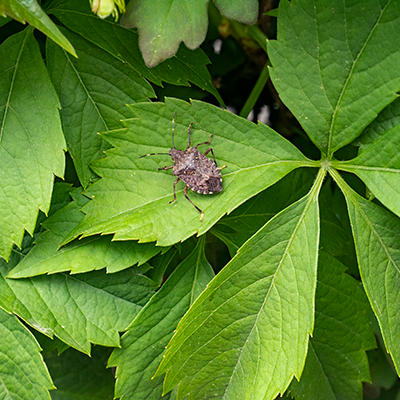After the unrelenting heat of summer, fall weather feels like a lovely reprieve. Unfortunately, with the arrival of apple cider, sweater weather, and football season comes many unwanted bugs. As the weather cools off, many household pests will seek shelter in our homes to escape the cold night temperatures. Not only do bugs make us feel uneasy in our own homes, but some can also even carry unwanted odors! Learn about some common pests found in Ohio during the fall.
Common Fall Bugs Found In Ohio Homes
Brown Marmorated Stink Bugs
The rest of the year, you’ll find these bugs on fruit trees and in vegetable patches, as fresh produce is their food source. But when the temperatures dip, you can easily find them inside. Like many bugs nowadays, stink bugs are an invasive species. Commonly found in the northeast, midwest, and west coast, they are most notorious for the horrible odor they emit when squashed. This odor is difficult to get rid of, and it makes killing them challenging. After all, your first reaction to finding a big bug in your home is probably to grab the nearest paper towel or shoe. But doing so for stink bugs will leave you with a mess and a horrible odor. Adult stink bugs are roughly half an inch long and come in different shades of brown. Like other stink bugs, they have a “shield” shape to their bodies. To differentiate them from other stink bugs, you’ll notice lighter colored bands on their antennae and dark bands near the rear part of their front wings. Their eggs are oval in shape but extremely tiny – about 1.3 mm. Female stink bugs will attach them to the undersides of leaves in groups of 20 to 30 eggs.
In humans, stink bugs can cause rhinitis and conjunctivitis in people who are sensitive to the odor. In addition to smelling horrible when crushed, if exposed to skin, they can cause dermatitis.
Boxelder Bugs
Boxelder bugs are named for the trees – boxelders – where they make their homes. They’re generally considered harmless but are still considered a pest due to their activity. Unfortunately, when box elder bugs find their way in, they usually do so in large numbers. They like to seek out places that get lots of sun, so be sure to inspect your southern and eastern-facing windows for signs of them. At first glance, they may look like fireflies as they are about the same size and shape, but they have more vivid coloring. Adults are about half an inch long with black bodies covered in orange or red markings. Look for three stripes right behind the head. They actually belong to the same family as stink bugs are cicadas, though thankfully, they don’t produce bad odors or a nerve-wracking noise.
Cluster Flies
Most active in the fall, cluster flies will seek out sunny areas of your home to stay warm. Fortunately, they do not breed indoors, but they will utilize your home for warmth. A bit larger than a housefly, they are actually slower, which makes them an easier target for the fly swatter. Adults are up to half an inch long with grayish-black coloring and gold hairs. They get their name from their “clustering” behavior. They will group, especially in attics, and gather on windows. They don’t cause any damage to property or carry diseases, but they will leave dark, discolored spots of droppings on windows and walls.
Asian Lady Beetles
Often mistaken for native ladybugs, this invasive species was intentionally introduced to the U.S. by the Department of Agriculture – ironically, to combat pests like aphids. October is when you’ll start finding them indoors, as well as the exterior of buildings where there’s ample sun. It’s not unusual to discover thousands of them in attics and walls. Once inside your house, they will continue to stay active. Killing them produces a foul order, and they leave behind an orange stain. Like stink bugs, Asian lady beetles can cause eye irritation and asthma in those individuals sensitive to odors. They’re also harmful to dogs if ingested. The easiest way to tell them apart from ladybugs is to look at their heads. Both Asian lady beetles and ladybugs have red or dark orange bodies, but the Asian lady beetle has an M-shaped white blotch on its head. Asian lady beetles are also slightly bigger than ladybugs.
Western Conifer Seed Bug
This invasive species is named for the fact that they feed on cones of evergreen trees. Originally found on the west coast, this bug is now common across the northern U.S. Adults are 3/4″ long and brown in color. The upper side of the body is yellow or light orange with black patches. While flying, they produce a noticeable buzzing sound, like that of bumblebees. While they don’t breed indoors, the bugs will seek out your home to shelter through the winter. If left undisturbed, they’ll emerge in late May or early June. While western conifer seed bugs do not cause problems like bites or stings, having one in the house can be quite frightening, especially if a swarm is developing.
Where We Service
We currently service these locations and more!
